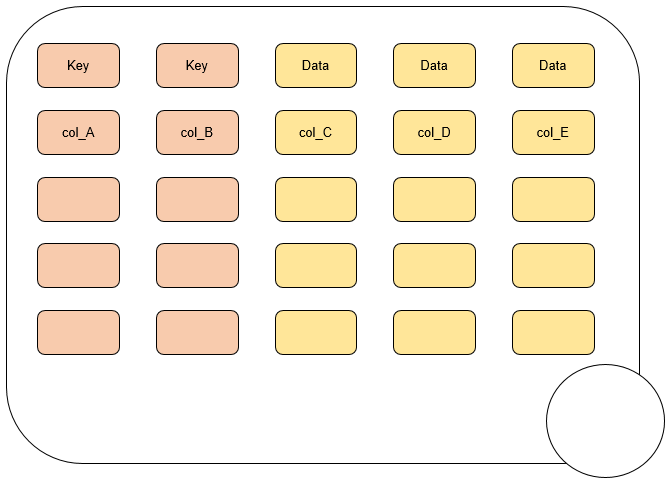Declaring Hash Objects
A Brief Overview
Hash
objects are helpful when performing table lookups. A hash
object is an in-memory table that contains key and data
components. In the following example, the hash object contains two
key columns, col_A and col_B, and three data columns, col_C, col_D,
and col_E.
Figure 12.1 Hash Object with Key and Data Components

You can quickly and
efficiently store, search, and retrieve data based on the key components.
When the key component values are found, the data values are copied
to the program data vector (PDV).
The use of hash objects
is specific to the DATA step. A hash object is available only to
the DATA step that creates it. When the DATA step is over, the hash
object is deleted. Whereas an array is defined at compile time, a
hash object is defined at execution. This makes the size of a hash
object dynamic, and that means that the object can expand and shrink
as data is added or deleted.
A hash object resembles
a table with rows and columns and contains key and data components.
Key Components
-
Key components can consist of one or more key columns.
-
Key components can be numeric, character, or both.
-
Key components must be defined as PDV columns, and your hash object does not have to be sorted by the keys.
-
Be default, each row of keys must be unique.
Data Components
-
You can have multiple data components per each row of key components.
-
Data components can be numeric, character, or both.
-
Data components must be defined as PDV columns.
Declaring a Hash Object
The DECLARE statement
creates an instance of data, and initializes data for an object. Use
the DECLARE statement to name your hash object and specify information
such as the name of the table that should be used to load the hash
object.
|
Syntax, DECLARE statement:
DECLARE object object-name(<argument_tag-1:value-1,
...>);
object
specifies the component
object. An object can be one of the following values:
hash
indicates a hash object.
hiter
indicates a hash iterator
object.
object-name
specifies the name
of the hash object.
argument_tag-1
specifies the information
that is used to create an instance of the component object.
DATASET: 'data-set-name <(data-set-option)>'
value
specifies the value
for an argument tag. Valid values depend on the component object.
|
In the following example,
you are creating a hash object named States. The example does not
contain any arguments or tag values. The parentheses are still required.
declare hash States();
In the following example,
you are reading the data for the hash object from a table. In the
example, the DATASET argument loads the Work.Population_USStates table
into the hash object. After the argument DATASET, place a colon and
then the value of the argument. If you specify a literal value for
the table, enclose the value in single or double quotation marks.
Within those quotation marks and after the table name, specify data
set options such as WHERE=, DROP=, KEEP=, RENAME=, or OBS=.
declare hash States(dataset:'work.population_usstates
(where=(StatePop2017>20000000))');
If you have duplicate
key values, use the MULTIDATA argument in the DECLARE statement. If
you want to allow duplicate key components, then set MULTIDATA to 'YES'.
The default value is 'NO'.
declare hash ContName(MULTIDATA:'YES');
Hash Object Process
Besides declaring the
hash object, you must also provide key and data components by using
the three DEFINE methods. Once the hash object is declared and defined,
the hash object can be used. Finding values in a hash object is only
one of the ways that you can use hash objects. Other ways include
adding data to the hash object and writing data from the hash object
to an output table.
|
Steps
|
Syntax
|
Example
|
|---|---|---|
|
Declare the hash object.
|
DECLARE object object-name (<argument_tag-1:value-1, ...>); |
declare hash ContName(); |
|
Define the hash object.
|
object-name.DEFINEKEY('key-1' <, ...'key-n'>); |
ContName.definekey('ContinentID');
|
object-name.DEFINEDATA('data-1' <, ...'data-n'>); |
ContName.definedata('ContinentName');
|
|
object-name.DEFINEDONE( );
|
ContName.definedone(); |
|
|
Use the hash object.
|
object-name.FIND(<KEY:value-1, ... KEY:value-n>); |
rc=ContName.find(); |
Last updated: October 16, 2019
..................Content has been hidden....................
You can't read the all page of ebook, please click here login for view all page.
